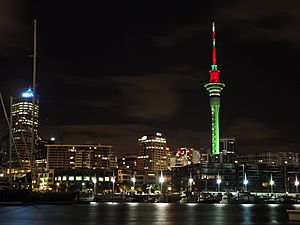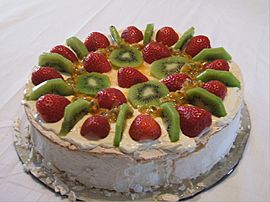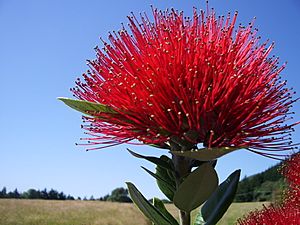Christmas in New Zealand facts for kids

Christmas traditions in New Zealand are similar to those in Australia. They incorporate a mix of British and North American traditions, such as Christmas symbols featuring winter iconography. However, the timing of Christmas occurring during the Southern Hemisphere's summer season has resulted in the development of some local traditions as a result of the warmer weather. New Zealand Christmas dishes include summer fruits and vegetables, a variety of meats and seafood, and pavlova (a meringue-based dessert popular in Australasia). The New Zealand Christmas tree, the pōhutukawa, is displayed as well as the traditional Northern European tree.
Christmas (Māori: Kirihimete), observed on 25 December, became widely celebrated in the late 19th century among Pākehā (European) settlers. Today, Christmas Day and Boxing Day are both statutory holidays in New Zealand. While Boxing Day is a standard statutory holiday, Christmas Day is one of the few days of the year where all but the most essential businesses and services must close.
History
The Christian festival of Christmas was introduced to New Zealand by missionaries in the early 19th century. There was no known equivalent festival celebrated by Māori prior to European settlement. The first recorded Christmas service on New Zealand shores was in 1814, with Rev. Samuel Marsden delivering a sermon to around 400 Māori at Oihi Bay in the Bay of Islands, at the invitation of chiefs Te Pahi and Ruatara.
In the mid 19th century observance of the Christmas holiday varied along sectarian grounds. English and Irish settlers, who were typically Anglicans and Catholics respectively, brought their own Christmas traditions. Scottish settlers did not widely celebrate Christmas as the Scottish Presbyterian church never placed much emphasis on the Christmas festival, on the grounds that it was unscriptural. In the late 19th century the Presbyterians began to embrace Christmas celebrations, and as sectarianism between the different ethnic communities decreased the holiday became widely observed by all New Zealanders—albeit as a low-key, private affair until the late 20th century.
Christmas Day became a bank holiday following the Bank Holidays Act 1873, and all workers were entitled to a day off for Christmas as a result of the Industrial Conciliation and Arbitration Act 1894. The Public Holidays Act 1910 further established Christmas Day and "the day after Christmas Day" (Boxing Day) as non-working days.
Imagery and decorations
New Zealanders celebrate Christmas with traditional Northern Hemisphere winter imagery mixed with local and biblical imagery. Native plants, ferns, and flaxes are displayed alongside traditional Christmas flowers such as mistletoe, and biblical stars and angels. The pōhutukawa, which produces large crimson flowers in December, is an often used symbol for Christmas in New Zealand, and subsequently the pōhutukawa has become known as the New Zealand Christmas tree.
Some homeowners decorate the exterior of their houses. Displays range from the modest to elaborate, sometimes with hundreds of lights and decorations depicting seasonal motifs such as Christmas trees, Santa Claus, reindeer, or nativity scenes. Particular regions have a tradition for elaborate displays, and attract a great amount of pedestrian and vehicular traffic during the Christmas season. This is despite the longer days, with dusk ranging from 9:05 p.m. in Gisborne (New Zealand's most northeasterly city) to as late as 10:20 p.m. in Invercargill (the most southwesterly city).
Food

Families traditionally gather for a Christmas Day lunch. While a formal dinner indoors remains traditional, barbecue lunches have increased in popularity since the 2000s, with around 43% of New Zealanders having a barbecue lunch in 2019.
Christmas lunches commonly include lamb, ham, beef, root vegetables such as potato and kūmara (sweet potato), and a variety of salads. As appropriate for the often warm summer temperatures of the day, it has become popular to serve cold meats and seafood (such as eel). Traditional Northern Hemisphere Christmas foods, such as turkey and brussels sprouts, were common in the past and continue to be eaten by a minority. Similarly, sweet dishes include both traditional British Christmas desserts (such as Christmas cake, Christmas pudding, fruit mince pies, and trifle) and local desserts such as pavlova topped with summer fruits (such as strawberries and raspberries) or kiwifruit.
Parades
Several Christmas themed parades are held in New Zealand. A popular event is Auckland's Santa Parade down Queen Street. This features numerous floats and marching bands and attracts large crowds every year. It is held late November to accommodate holidaymakers and is seen as the preamble to the later festivities. The tradition of Carols by Candlelight is popular in New Zealand, especially in Auckland and Christchurch, where there are usually large outdoor carol-singing gatherings known as Christmas in the Park.
Retail
The lead-up to Christmas is the busiest shopping season in New Zealand. Paymark, who provides EFTPOS services to 70 percent of retailers, recorded a total spend of $8.6 billion of transactions through its network in the six weeks leading up to Christmas 2019. On Christmas Eve 2019, the Paymark network processed 199 transactions per second at peak times.
Black Friday sales began to be adopted by New Zealand retailers in 2013, largely to remain competitive with US-based online retailers. In 2015, major retailers such as The Warehouse, Noel Leeming and Harvey Norman offered Black Friday sales, and by 2018 were joined by Farmers, JB Hi-Fi, Briscoes and Rebel Sport. Paymark processed $253 million in transactions though its network on Black Friday 2019, overtaking Boxing Day for the first time.
Media
As Christmas falls in summer, watching television is not as strong a part of New Zealand Christmas traditions as many northern hemisphere countries. Most regular television series and current affairs shows go off-air from mid-December to mid-to-late January. No advertising is allowed on New Zealand television or radio on Christmas Day, a rule that also applies on Good Friday and Easter Sunday.
Many television channels rerun Christmas-themed films in the weeks leading up to and including Christmas Day.
TVNZ 1 broadcasts the Royal Christmas Message at 6:50 pm. The message has been broadcast on television since at least 1961.



